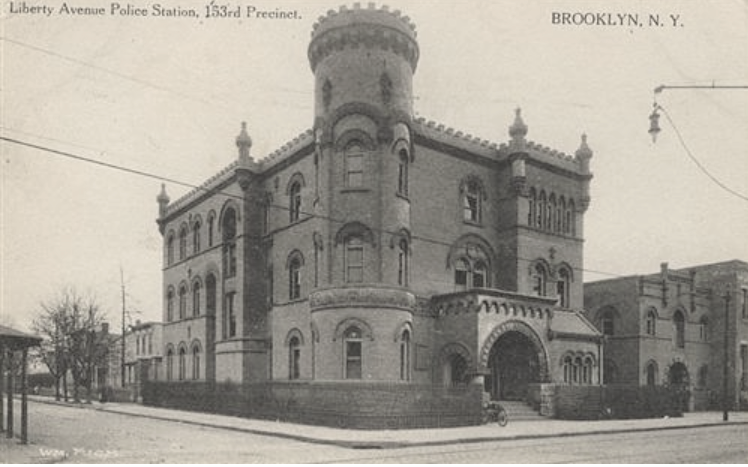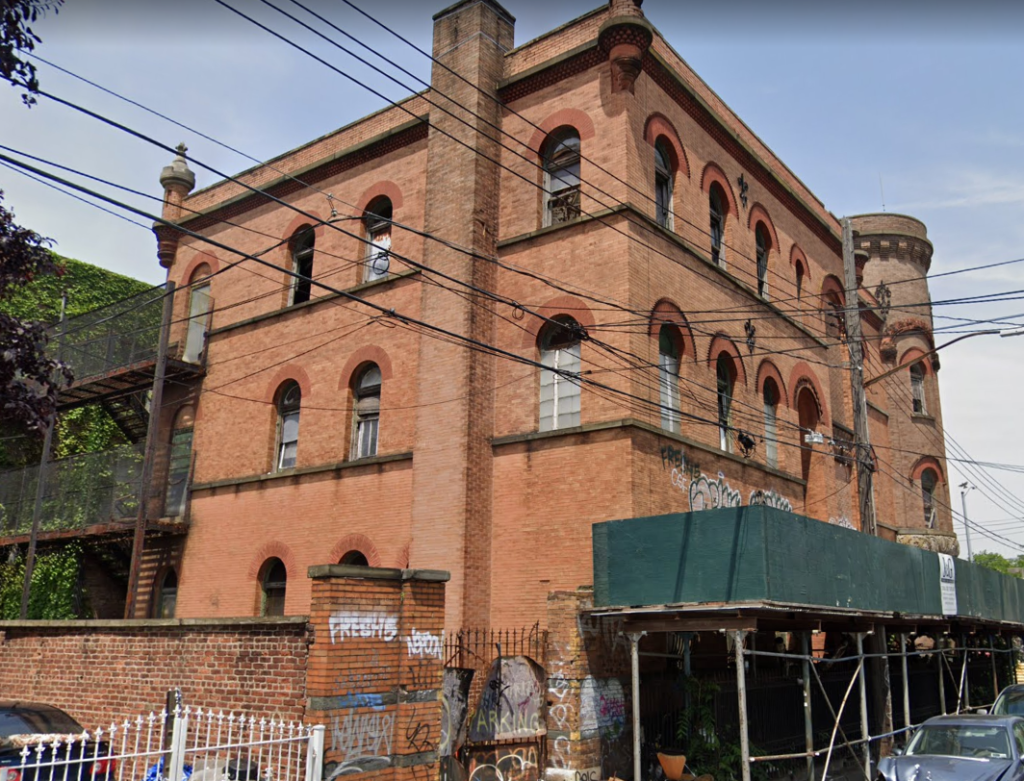
Part I: The Police Cats of the 153rd Police Precinct
When Dewey, a large tabby cat, entered the magnificent, castle-like police station at 484 Liberty Avenue in 1902, he was the terror of the precinct. Biting and scratching were his favorite pastimes.
But over the next seven years, Dewey (no doubt named for Commodore George Dewey, the hero of the Spanish-American War) grew into one of the kindest and mildest of cats. He also became one of the best ratters in the New York Police Department.
The credit for the remarkable turnaround goes to Mrs. Henrietta Millwood, the veteran “white-haired, gentle-faced” police matron for what was then known as the 153rd Police Precinct of East New York, Brooklyn.
“I remember well the night that Dewey first came to the station house,” Mrs. Millwood told a Brooklyn Times Union reporter in August 1909. “He came in for shelter out of a storm and a more bedraggled little animal it would be hard to find. He was starving.”
Mrs. Millwood said that after feeding the cat, he refused to leave. No surprise there.
She then trained the cat by bopping him gently on the nose whenever he did wrong. “An animal could be made to comprehend things at once by using this method,” she told the reporter, explaining that the nose was the “seat of understanding.”

Dewey shared the Romanesque Revival style police station with Dick, a large black and white cat who showed up a few days after Dewey arrived (the cat obviously had a nose for food and luxurious shelter). Like Dewey, Dick was a great mouser who took his job very seriously—even passing up a photo shoot and publicity for a more important ratting expedition.
Around the neighborhood, Dewey and Dick were known as the 153rd Precinct mascots. Every man, woman, and child in the district knew them and fed them treats.
Many working mothers would leave babies and toddlers on the police station steps every morning on their way to their jobs in Brownsville. (“Little moms or dads,” in other words, children who had been placed in charge of their younger siblings, would also drop off the little ones at the station.) Moms and older siblings knew the youngsters would be taken in and cared for by Mrs. Millwood and the other matron, Mrs. Cox, so they abused the system and used the police station as a day care center.
Dewey and Dick were no doubt a favorite attraction for these abandoned children who spent the entire day at the police station. The kids also adored Mrs. Millwood, who kept a room filled with toys, including rag dolls and ninepins, for the girls and boys to play with. (Mrs. Millwood told the Times Union reporter that the bad adult mothers should be disciplined: she suggested fining them one dollar each time they dropped off their children. Perhaps she should have bopped them on the nose each time!)
Although Mrs. Millwood was their disciplinarian, the cats were under the charge of Henry Miller, who was in command of the horse stables and patrol wagon, and John Ott, who was in charge of the precinct horses. The men saw that the cats were fed and well taken of; they reportedly did such a good job at taking care of Dewey and Dick that the cats were “the sleekest looking in East New York.”
The Cats’ Favorite Equine Pals

In 1909, there were 14 horses in the stables attached to the Liberty Avenue police station, including Nobel and Latson, the patrol wagon horses. According to Mrs. Millwood, Dewey and Dick could recognize each horse. They also had a few favorites.
One of the cats’ favorite horses at the precinct was Black Mike, a handsome black bay horse who belonged to Officer Martin Volkommer, a former Rough Rider who fought with Teddy Roosevelt in the Battle at San Juan Hill. Dewey and Dick reportedly loved to sleep in the same stall with him.
Black Mike was a gentle horse with felines and humans alike. According to Mrs. Millwood, whenever Officer Volkommer was ready to mount the horse, Black Mike would “bend down” by stretching out his two fore legs. “It’s the cutest thing I have ever seen,” she said.
Another of the cats’ favorite equine pals was a 22-year-old black horse also named Mike. This horse now belonged to Captain Christian Reimels, but he first joined the old New Lots Police Department under Captain Hugh F. Gorman, who was the first captain to assume command of the new Liberty Avenue police station in 1892.
Mike was known to be a devil under Captain Gorman’s command, but by 1909 he was reportedly “as gentle as a kitten.” Maybe Dewey and Dick had something to do with this, or maybe Mrs. Millwood gave him a few taps on the nose.
On the night before the Times Union reporter visited the station, Mike had taken a bad turn. His injuries were not immediately apparent to the humans, but somehow the cats knew that Mike was not feeling his best. They made this known to Daniel Miller.
According to the story, Dewey and Dick wakened Daniel from his sleep by “filling the air with their cries.” Then they began trotting backwards and forwards toward Mike’s stall, mewing loudly and showing obvious signs of distress.
Daniel was just about to throw a shoe at the cats to shoo them away, but their odd behavior caught his attention. On investigating the situation, Miller discovered that the old horse had been injured and required medical attention.
I trust that Dewey, Dick, and their horse friends lived happily ever after in their fairytale police station. In Part II of this story, I’ll tell you about Sergeant Nick, the Newfoundland mascot of the New Lots Police who preceded the mascot cats.
The Police Station Castle at 484 Liberty Avenue
Completed in 1892, the historical Liberty Avenue police station designed by George Ingram was built of Anderson gray brick and Lake Superior sandstone. Other features included two polished Quincy columns, main entrance doors of quartered oak, and elaborate interior finishes of quartered oak and black walnut.
The building stood on a site purchased by the city on the southwest corner of Liberty and Miller Avenues. This was about two blocks away from the old station house of the original New Lots Police Department at 109 Bradford Street.

The main building could accommodate about 80 patrolmen, and featured a large muster room, captain’s quarters with a bedroom and bathroom, a large sitting room, four dormitories, and rooms on the second and third floors for the patrolmen and sergeants. There was also a matron’s office in a hall leading to the stables, plus two cells for female prisoners and eight cells for men.

The connected stables were to the right of the main building. They were designed to accommodate the patrol wagon and a dozen or so horses of the new mounted squad. The corner turret also served as a watchtower, where an officer could sit and look out for fires in the district (in later years, veteran officers would tease the rookies and tell them they would get stuck with the fire watch detail if they got out of line).
When newly appointed Captain Hugh Frank Gorman and the men of what was then called the 17th Police Precinct moved into their new home at 6 p.m. on June 2, 1892, the force was the smallest in the city with only 38 men. Now that they had a new station house, the force expanded to about 60 patrolmen, including the mounted unit with 14 horses and at least two police cats.
During this time period, the district was the largest in the city, covering nine square miles stretching from Queens County to the town of Flatbush, and from Jamaica Bay to the county line. The district included East New York, Brownsville, and Cypress Hills.
Although it was thickly populated in Brownsville, the majority of the district was rural, with farms and numerous detached homes that were magnets to burglars.
The Final Years of the Liberty Avenue Police Station
By 1909, when this story of Dewey and Dick took place, Captain Gorman had already been dead for 11 years, having passed away at the young age of 48 on March 1, 1898, from cirrhosis of the liver. Sadly, he died only one year after his retirement.
East New York had also far outgrown its police facilities. The Liberty Avenue building had a maximum capacity of 113 police officers, which was not enough to protect the 90,000 people living among the 139 miles of streets in the district.

Some of the 80 street posts were now more than two miles long, and with sick time and vacations, there were oftentimes as few as 40 men to cover all those posts. The people of Cypress Hills, in the northern portion of the large district, were demanding more coverage. They’d have to wait a long time.
With the advent of the motorized patrol car, the horse stables were replaced by a three-story garage in the 1920s, when this was now the 44th precinct. Around 1930, the precinct was renamed the 75th Police Precinct.
The NYPD stopped using the building in 1973–almost 65 years after the residents began demanding a new station! By this time, the police were in desperate of need of not only more space, but also many more electrical outlets and bathrooms.
A modern new headquarters for the 75th precinct was finally established at 1000 Sutton Avenue.
In September 1975, the city announced that it would be selling the Liberty Avenue building—along with 400 other buildings and lots—at a large public auction. The starting bid was set at $15,000; the city would only accept bids from a community group that would use the police station for nonprofit purposes.
The winning bidder was the Peoples Baptist First Church, which occupied the building into the early 1980s.

Eventually, the building was vacated and left to deteriorate. Windows were knocked out and the doors were barricaded with wood that rotted over time.
Then in 2016 it was purchased by David Krinsky of Triple Five Holdings LLC. Numerous permits were issued in the summer of 2021, so hopefully the building will one day be restored to its original glory.
In Part II of this story, I’ll share the interesting history of the New Lots Police Department and the old station houses that led up to the castle at 484 Liberty Avenue.





